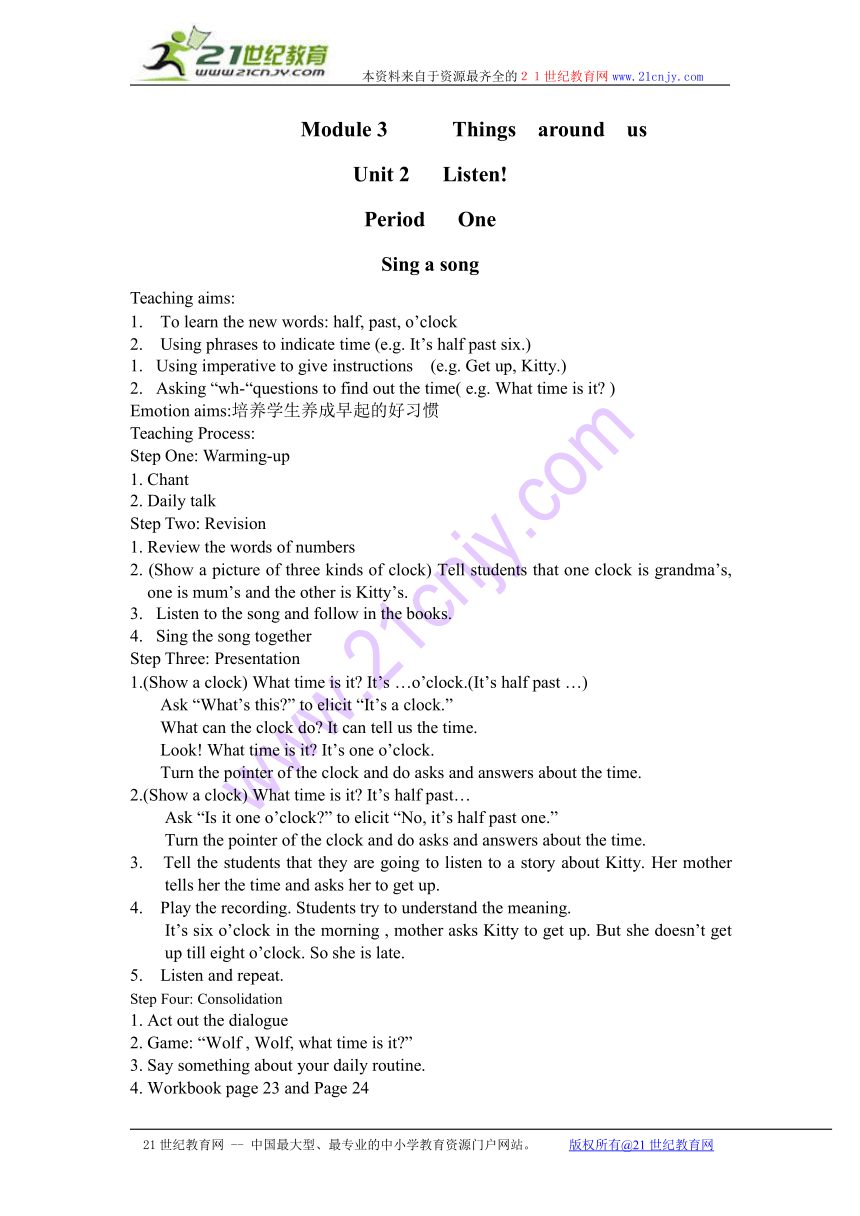
本资料来自于资源最齐全的21世纪教育网www.21cnjy.com Module 3 Things around us Unit 2 Listen! Period One Sing a song Teaching aims: 1. To learn the new words: half, past, o’clock 2. Using phrases to indicate time (e.g. It’s half past six.) 1. Using imperative to give instructions (e.g. Get up, Kitty.) 1. Asking “wh-“questions to find out the time( e.g. What time is it ) Emotion aims:培养学生养成早起的好习惯 Teaching Process: Step One: Warming-up 1. Chant 2. Daily talk Step Two: Revision 1. Review the words of numbers 2. (Show a picture of three kinds of clock) Tell students that one clock is grandma’s, one is mum’s and the other is Kitty’s. 1. Listen to the song and follow in the books. 1. Sing the song together Step Three: Presentation 1.(Show a clock) What time is it It’s …o’clock.(It’s half past …) Ask “What’s this ” to elicit “It’s a clock.” What can the clock do It can tell us the time. Look! What time is it It’s one o’clock. Turn the pointer of the clock and do asks and answers about the time. 2.(Show a clock) What time is it It’s half past… Ask “Is it one o’clock ” to elicit “No, it’s half past one.” Turn the pointer of the clock and do asks and answers about the time. 3. Tell the students that they are going to listen to a story about Kitty. Her mother tells her the time and asks her to get up. 4. Play the recording. Students try to understand the meaning. It’s six o’clock in the morning , mother asks Kitty to get up. But she doesn’t get up till eight o’clock. So she is late. 5. Listen and repeat. Step Four: Consolidation 1. Act out the dialogue 2. Game: “Wolf , Wolf, what time is it ” 3. Say something about your daily routine. 4. Workbook page 23 and Page 24 1. Grammar Practice Book 4B, page 33 Step Five: Assignment 1.Listen to the tape and read the text for several times 2.Copy the new words and the sentences. 3.Talk the daily life with your parents 课 后 随 笔 Period Two Look and talk Teaching aims: 1. Using imperative to give instructions. (e.g. Come and eat.) 2. Using impersonal ”it” to express time (e.g. It’s one o’clock.) 3. Using “wh-“ questions to find out the time. (e.g. What time is it .) 4. Using formulai expressions to express apologies. (e.g. I’m sorry. ) Emotion aims:培养学生良好的学习习惯和生活习惯 Teaching Process: Step One: Warming-up 1.Sing a song 2. Daily talk S1:What time is it S2:It’s …o’clock. S1:What time is it S2:It’s half past … Step Two: Revision 1. Review the time expressions. 2. Act out the dialogue 3. Say something about your daily life. S: I’m… I get up at … I go to school at… I have lunch at… I do my homework at… I watch TV at… I have dinner at… I go to bed at… Step Three: Presentation 1. (Show the pictures of page 37) Ask the students to look at the pictures and find out the time in each picture. (write) nine o’clock half past eleven half past twelve five o’clock half past nine seven o’clock 2. Divide the students into groups. Ask them to complete t ... ...
~~ 您好,已阅读到文档的结尾了 ~~

